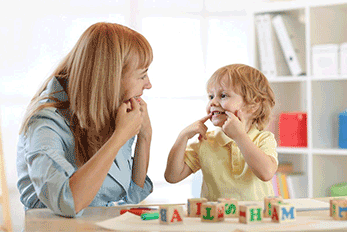
Asking and answering ‘Wh-‘ questions is a key part of language development. Children must be able to understand questions in order to have a conversation and pass on information to others. Starting to ask and answer ‘Wh-‘ questions is a milestone that most children start to reach between the age of 1 and 2 years, and they’ll continue to develop their receptive and expressive language in the lead up to school.
What Are Wh- Questions?
Wh-questions are certain types of questions we ask to get information about different things and are used frequently every day at home and in the classroom:
- Who – asks about a person (eg. ‘who won the race on Saturday?’)
- What – asks about something (eg. ‘what is that?’)
- When – asks about a time (eg. ‘when do you finish work?’)
- Where – asks about a place (eg. ‘where are we going?’)
- How – asks about the manner, condition or quality (eg. ‘how does this work?’)
- Why – asks about a reason (eg. ‘why is the sky blue?’)
Why Are They Important?
It is important that children ask and answer Wh-questions, as they lay the groundwork for children to participate in conversations, demonstrate knowledge, and collect information about themselves and their world. Children learn Wh-questions in a sequence starting with more concrete questions about their immediate environment – eg.“What” is the earliest question mastered, followed by “Who” and “Where.” Finally, an understanding of “When” and “Why” develop, with “Why” being the most difficult to master.
How Can You Help Your Child Learn to Understand and Answer Wh- Questions?
- Start with the easiest Wh- questions first (eg. what) and then progressing to harder, more abstract questions (eg. when)
- Working on only one question at a time to avoid confusion.
- Model answers to questions if your child is not sure how to answer them correctly (eg. ‘what did you have for lunch today? ….You had your sandwich and an apple’). Repeat the question to see if your child answers correctly after modelling.
- Provide multiple opportunities and repetitions of similar questions across different activities (eg. asking ‘what’ questions during book reading and using the same ‘what’ questions during a game of eye spy)
- Use visuals to represent different Wh- questions (eg. you might have picture of different places for ‘where’ questions or pictures of people for ‘who’ questions)
Activities That Can Help Build an Understanding of Wh- Questions
- While reading simple storybooks with illustrations or pictures, ask your child questions like, “Who is this? What is he/she doing? Where is the child going? When will he/she come back? Why is he/she leaving?” Practice these types of questions, as well as saying the answer.
- Ask questions about your child’s day at school using Wh-questions. “Who did you sit with at lunch? Where did the class go for music time? When did you play outside? What did you eat for lunch? Why did you bring home your books?
- Cut pictures from magazines/books. Make a Wh-question chart with each type of question in a separate column. Show your child a picture and ask him/her to place the picture in the correct column. For example, you show the child a picture of a man – he/she puts the picture in the Who column. An apple – he/she places in the What column; a picture of a park – he/she places in the Where column.
Download our Free Wh- Questions Resources
Our team has developed some practical resources to use with children to build their knowledge of wh- questions.
More Resources
Subscribe to Learning Links
In our free monthly eNewsletter, you’ll receive interesting articles on learning, development and wellbeing, tips for supporting children at home or at school, program and online learning updates and the latest news from the Learning Links team.




